Over the years I’ve heard a lot of admonitions about watering carefully in summer. And for good reason – trees can dry out quickly when its warm out. At a glance, it looked like most of my trees were over watered as moss was beginning to develop.

Green soil – a sign that the soil has been wet lately
This didn’t totally make sense to me. I’m used to trees drying out at a certain rate and seeing green soil made me question the assumption that green means wet. I investigated.
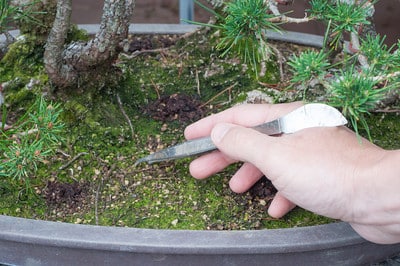
Removing surface soil with bent nose tweezers
It turns out that the soil was fairly dry and the tree in need of water. What happened?
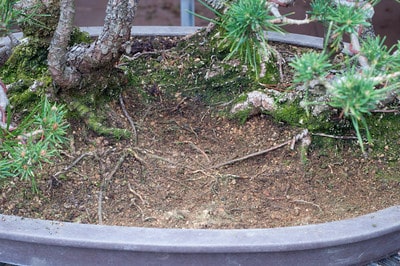
Dry soil
Some cool weather a few weeks back meant that the the soil on my trees dried out slowly. Moss started to grow. When it warmed up, the soil stayed green, making it hard, at a glance, to tell if my trees needed water. In the case of this pine planting, I removed all of the old surface soil and added some new soil.
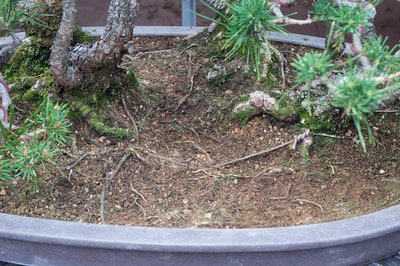
Old surface soil removed
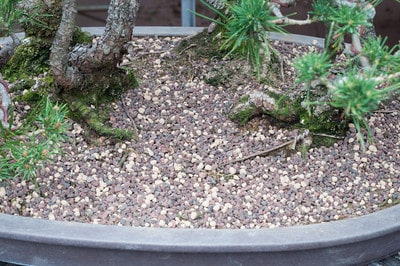
Top dressing added – lava and akadama
After adding the top dressing, I watered the trees and added some new fertilizer.
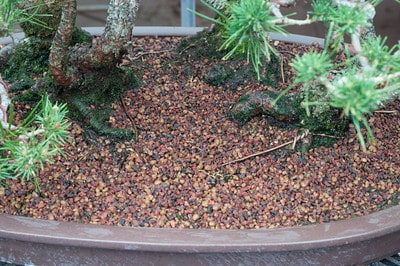
After watering
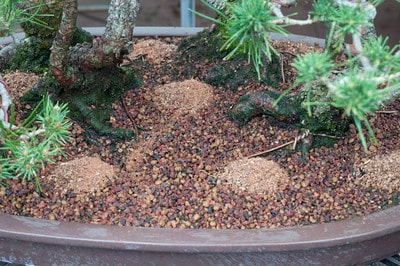
Piles of cottonseed meal
I found similar cases on a number of trees, including the black pine below. After removing the surface soil, I added top dressing and watered the tree.
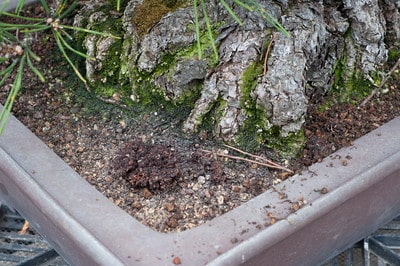
Old soil – dark from decomposed fertilizer and new moss
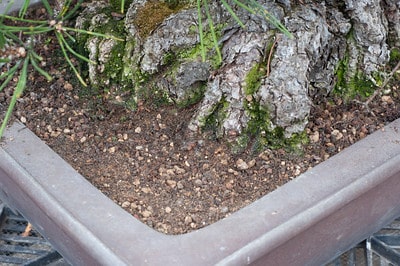
Surface soil removed
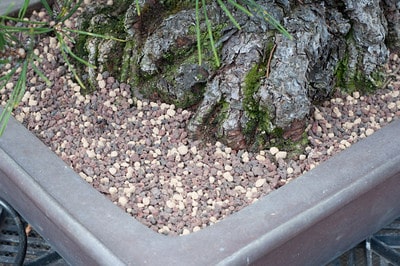
Top dressing added
My small azalea showed more signs of moisture – healthy moss growing on the surface of the soil. Was the soil here wet or dry?

Healthy moss
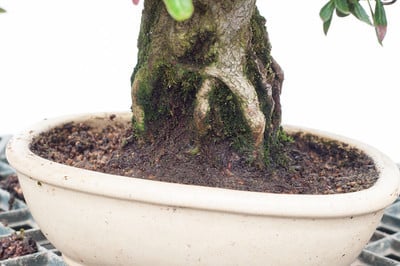
Beneath the moss – wet soil
The azalea soil was quite moist. After placing the shohin tree on a bed of lava (see “Keeping bonsai from drying out in summer“) I’ve had a much easier time keeping it from drying out. I performed soji anyway (see “Summer Soji“) and added white sphagnum moss to retain extra moisture.

White sphagnum moss
Next I looked at my hornbeam. Surely this tree was getting enough water?
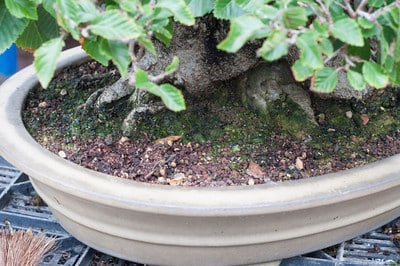
Old soil on a Korean hornbeam
I removed the surface soil and found yet another dry tree.

Dry soil
Healthy hornbeams are thirsty trees, and the pot in this case is on the small side. I removed the surface soil, added fresh soil, and covered this with white sphagnum to help retain moisture.
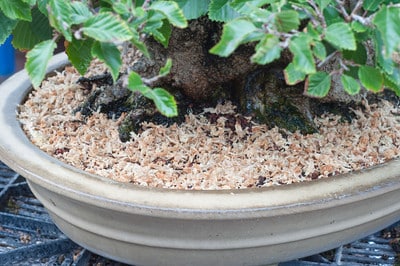
White sphagnum top dressing
I’ve since checked all but a few of my trees, cleaning a lot of the old soil that made watering tricky. Now it’s easier to tell which trees need more water, and which need less. Thinking how nice it would be to be around enough to water each tree when it needed it, I again realized a key benefit to the apprentice system.
Subscribe to Bonsai Tonight
New Posts Delivered Every Tuesday and Friday
Judy B says
How are you able to tell if the lower soil is actually getting wet, and not just the top layer of new soil? I find that when my trees have been on the dry side, that sometimes watering will not thoroughly wet the older soils without very careful and slow watering, and going back over it several times. It always surprises me to see the water pouring out of the bottom of the pot, and then digging down in the soil, to see how it just runs off without wetting. (this is in a modern non organic substrate…)
Mac says
I buy a bags of bamboo chop sticks from the grocery and keep two or three bags in my supplies all the time. If you stick a chop stick in the pot, and leave it there, so the tip is touching the bottom you can use it like a dip stick in a car.
Every day, when I water, I pull the chop sticks out look at the end that was in the soil. Make a judgement as to how dry the soil is all the way to the bottom and a judgment as to if that particular tree needs or doesn’t need water. That I determine by the type of tree, the size of the pot in relation to the roots, type of soil in that pot. Pines I wait till I can just feel dampness in the chop stick, almost completely dry before watering. Stewartia, Wisteria like a lot of water and unless there is free water clinging to the stick they get lots of water. I have a few Winged Elm in training baskets and one in a shallow large rectangle. The ones in training pots I leave off water if the chop stick is good and damp. The one in the shallow rectangle gets water more often since it drys out quicker.
It only takes about 15 – 20 seconds to check the water needs on 10 plants on a shelf and then I water that shelf and move on to the next one.
The bamboo chop sticks last about a year before rotting to the point they break off when they hit something hard in the pot. I just break out a new one and stick it in the pot. When the tree is going off someplace for display I just pull the chop stick and leave it on the shelf till the tree comes back.
Jonas Dupuich says
Hi Judy – the best way to see what’s going on below the surface is to check once in a while. Mac’s solution or simply scraping away some of the surface soil with a chopstick or tweezers is a good place to start. Excessive dryness leads to wilt – too much water leads to root problems. Periodic checks while taking into account soil type, the weather and whether or not there is old soil in the rootball will help stave off these extremes.
Gary T says
Jonas
By pure coincidence I noticed this problem on a raw material Japanese Larch, purchased earlier in the year in a deep pot, just before seeing this blog post.
I had already removed the moss (again!) and tried to gently aireate the soil with a skewer. This wasn’t very sucessful as the soil is very compacted, so I was at a loss what to do.
Thank you for posting this, I now have a much better idea what needs doing. Though, like Judy B I do wonder how to ensure the problem isn’t simple shifted further down into the pot?
Thank you again for the helpful blog, I now know to check all my other plants, material and tree’s.
Mac says
Perhaps I didn’t make clear what I was describing.
I don’t scrape around the pot with a chop stick. I stick the chop stick straight down in the soil till the tip hits the bottom of the pot. I then leave it there. It stays in the pot 24/7. Any time I want to know how much moisture is in the soil of a particular tree I just pull it out and look at it. Have a cross section of the soil from top to bottom as to how much water is in the pot.
If the upper 1/2 is dry and some drainage problem held the water in the pot I can see it quite clearly on the chop stick. If it is dry to the bottom, same goes, it’s very obvious.